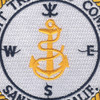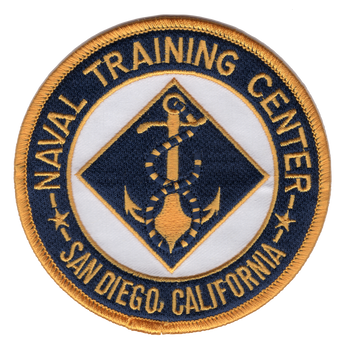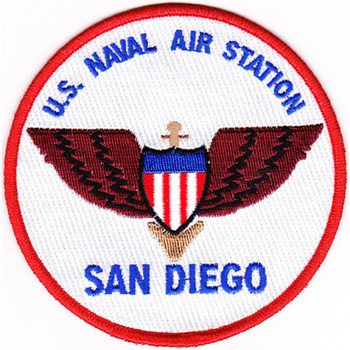Formations & Origins
The Recruit Training Command San Diego California Patch is a symbol of the United States Navy’s recruit training center located in San Diego, California. Established in 1923, Naval Training Center San Diego served as one of the two primary locations for basic training in the United States, with the other being Naval Station Great Lakes in Illinois. The patch represents the challenging yet vital role of training new sailors to prepare them for service in the Navy. Throughout its history, San Diego has been a focal point for instilling discipline, teamwork, and Navy values in thousands of recruits, making it one of the most significant military training locations in the country.
For much of the 20th century and into the 21st century, this command served as the primary recruit training station for Navy recruits, particularly those from the Western United States. The base played a crucial role in the post-World War II era, preparing recruits for the expanding Navy fleet during the Cold War and continuing to serve through multiple global conflicts and military operations.
Notable Commanders
While the Recruit Training Command San Diego didn’t have as high-profile commanders as combat units, the leadership at this training center has played an essential role in shaping the next generation of sailors. Commanding officers of RTC San Diego were tasked with overseeing the intensive training process, ensuring recruits were prepared to meet the Navy's standards for physical fitness, discipline, and teamwork.
One of the most notable figures associated with recruit training in San Diego was Admiral Elmo Zumwalt, the 19th Chief of Naval Operations. During his time as a young officer in the Navy, Zumwalt’s emphasis on modernizing the Navy helped shape the training at centers like San Diego. Though he was not directly in charge of RTC San Diego, his policies impacted the way recruits were trained, particularly in the area of leadership development and diversity.
Major Campaigns/Operations
As a recruit training command, the San Diego RTC wasn't directly involved in military campaigns. However, the recruits who passed through its gates were an integral part of nearly every major naval campaign and operation of the 20th and 21st centuries. From World War II to Vietnam, Operation Desert Storm, Operation Iraqi Freedom, and Operation Enduring Freedom, countless sailors trained at San Diego went on to serve in combat zones around the globe.
One of the largest shifts in its history occurred in the Cold War, when the base became an even more vital element of the U.S. Navy’s global readiness. With the U.S. Navy’s increasing involvement in various conflicts around the world, recruits were prepared at San Diego to meet the growing demand for sailors across a variety of specialized fields, including nuclear submarines, aviation, and surface warfare.
More recently, the Recruit Training Command San Diego trained recruits who would go on to support naval operations during the War on Terror, ensuring the Navy’s ability to operate across the globe, from the Middle East to the Pacific Ocean.
Specialized Role/Equipment
The Recruit Training Command San Diego was established to ensure that the U.S. Navy could quickly and efficiently prepare recruits for service. The training curriculum at San Diego was designed to take civilians and transform them into sailors, teaching them basic naval procedures, Navy etiquette, shipboard discipline, and physical conditioning.
The patch symbolizes the rigorous nature of this transformation. New recruits would undergo extensive training, including daily physical fitness regimens, classroom instruction on Navy history, the chain of command, and shipboard duties, as well as practical hands-on training in firefighting, damage control, and watchstanding.
Facilities at RTC San Diego were designed to immerse recruits in the Navy experience, with barracks, classrooms, and training areas specifically tailored to meet the demands of military life. In addition to the intense training schedule, recruits were taught Navy-specific skills such as basic seamanship, marlinspike seamanship, and survival training. By the time they graduated, recruits were expected to be physically fit, knowledgeable, and prepared for the demands of Navy service.
Acts of Heroism
The Recruit Training Command San Diego Patch doesn’t represent individual acts of heroism, but rather the collective effort of generations of sailors who underwent intense training to serve their country. Many recruits who passed through RTC San Diego went on to perform heroic actions during military operations.
One example would be sailors from RTC San Diego who went on to serve during World War II, Vietnam, and Korea, where many of them displayed extraordinary bravery. Medal of Honor recipients such as Seaman First Class John Basilone (WWII) and others who were trained at San Diego became symbols of bravery and selflessness in combat. These sailors, and the many who followed in their footsteps, demonstrated the values instilled in them during their training at RTC San Diego.
Additionally, sailors who passed through the gates of RTC San Diego served aboard ships that would later take part in daring rescue missions, combat operations, and humanitarian efforts. Many sailors served with distinction during Operation Desert Storm and the conflicts that followed, continuing the legacy of bravery and sacrifice that began with their basic training.
Legacy & Notable Achievements
The Recruit Training Command San Diego Patch is a testament to the legacy of the U.S. Navy’s ability to efficiently train its personnel and send them to serve in a variety of roles. Over decades, RTC San Diego produced a steady stream of sailors who went on to serve in all corners of the world, from the decks of aircraft carriers to the depths of submarines, in combat zones, and in humanitarian missions.
RTC San Diego was also a pioneer in incorporating new training methods as the Navy evolved, particularly as the fleet moved toward more technologically advanced systems. The base provided specialized training for sailors who would go on to operate complex machinery like nuclear reactors, advanced radar systems, and sophisticated weaponry.
Another achievement of RTC San Diego was the integration of women into Navy service. Beginning in the late 20th century, RTC San Diego played an important role in training women sailors as part of the Navy’s evolving policies. Women began to serve in more diverse roles, and RTC San Diego helped prepare them for success in these positions.
However, in 1997, the U.S. Navy officially closed the Naval Training Center San Diego, relocating recruit training to Naval Station Great Lakes in Illinois. Although the base was decommissioned, its legacy remains deeply ingrained in the lives of the countless sailors who passed through its gates, as well as in the Navy's ongoing commitment to training, service, and excellence. The patch symbolizes that enduring legacy and the crucial role that San Diego played in shaping the Navy into the force it is today.


















